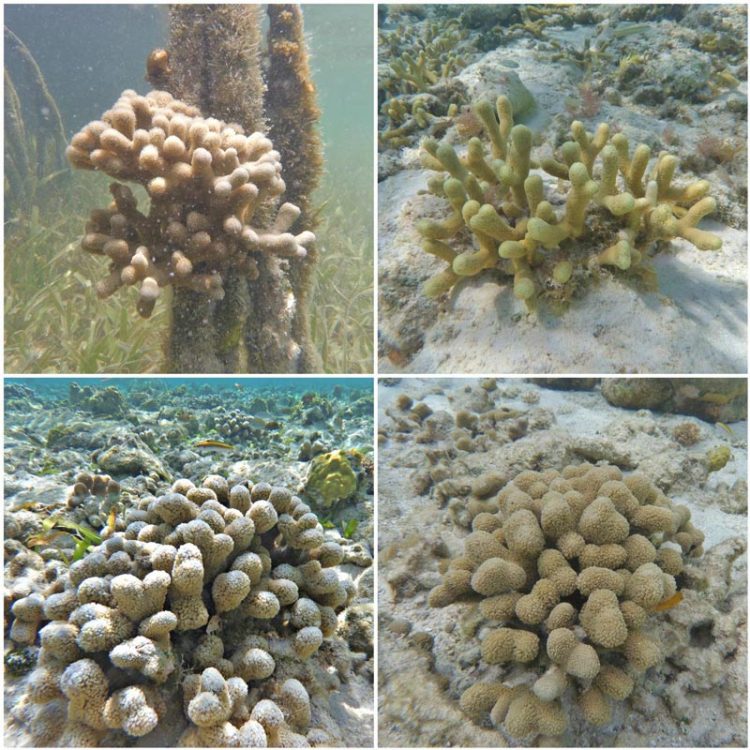Modern genetic sequencing tools give clearer picture of how corals are related

Porites porites can have spindlier branches (upper right) or thicker, knobbier branches (lower images). Scientists have debated whether or not they are the same species. Credit: James Dimond/University of Washington
University of Washington scientists are looking at the burgeoning field of coral genetics to better predict, and maybe even prepare for, coral's future threats. Their new study uses modern genetic-sequencing tools to reveal the relatedness of three similar-looking corals. “This coral appears to be three different species, but it's been debated whether it's really three separate species or whether it's one that's really variable in its appearance,” said first author James Dimond, a UW doctoral student in aquatic and fishery sciences.
Defining a species matters for conservation, because you can't monitor and protect a species if you don't know it exists.
“In the past we've relied on physical characteristics, like the coral skeleton, to determine what constitutes a coral species,” Dimond said. “But the problem with that is that corals can vary their skeletal architecture. So disentangling whether you have two different species or just a single species that's varying itself due to environmental conditions can be really tricky.”
Biologists had originally assumed that the widespread Atlantic corals were three species. Then a 2014 genetic study found that they were the same.
The new study, to appear in an upcoming issue of Molecular Ecology, finds new genetic evidence that they may, in fact, be three species. It also provides a glimpse into the epigenetics, a more mysterious form of genetic expression.
“It's the most in-depth analysis of coral epigenetics to date,” said co-author Steven Roberts, a UW associate professor of aquatic and fishery sciences. “It may also prompt a thorough re-evaluation of these corals' family trees.”
The study examined Porites porites, one of the more common types of corals. It is not among the roughly two dozen coral species listed as endangered. If it were to be listed in the future, biologists would need to know what constitutes a species.
The study used new tools to look at more than 1,000 single-letter changes in the genetic code, a marker of genetic diversity. The previous genetic study had looked at just 10 or 11 of these markers and found them to be the same in all three forms of coral.
“It appears to be a matter of looking more deeply into the genome, which is something we've only been able to do for the last couple of years,” Dimond said. “Molecular biology technology is changing so rapidly, and this is just an example of that.”
To definitively conclude that the three forms are, in fact, different species would mean using the same sequencing technique on more samples from across these corals' range, which includes the Gulf of Mexico, the Caribbean, the western Atlantic Ocean and off the coast of West Africa.
The authors also looked at epigenetics, which is any process that affects how the genetic code plays out in real life. Dimond's research focuses on the epigenetic process of DNA methylation, in which a carbon-based methyl molecule can bind to the DNA strand and thus affect how it gets translated into a protein that acts in the body.
The study's epigenetic analysis didn't show any consistent pattern among the different coral branch sizes, so was inconclusive. But the authors believe it provides a step forward in understanding this process in corals.
“It just gives a glimpse of the epigenetic variation within this group,” Dimond said.
Scientists are interested in coral genetics and epigenetics because it could help them predict how corals will adapt to continued changes in the ocean environment.
Coral genetics and epigenetics could also aid in the process of selective breeding, a topic of current interest that could help corals deal with potentially rapid changes in the ocean environment.
“Selective breeding involves finding individuals that are more tolerant of high temperatures and, in some cases, finding specific genes that confer resistance to higher temperatures,” Dimond said. “Once you're identified those genes and identified individuals that have those genes, then you can breed them, and seed reefs with those organisms.”
The new study, he said, is part of the fundamental research that could help toward achieving those goals.
###
The research was funded by a Hall Conservation Genetics Research Award from the UW College of the Environment, the ARCS Foundation Seattle Chapter, the John E. Halver Fellowship to the UW School of Aquatic & Fishery Sciences and the National Science Foundation. The other co-author is Sanoosh Gamblewood at Western Washington University in Bellingham.
For more information, contact Dimond at jldimond@uw.edu and 360-650-7400 x253 or Roberts at sr320@uw.edu or 206-866-5141.
Media Contact
All latest news from the category: Life Sciences and Chemistry
Articles and reports from the Life Sciences and chemistry area deal with applied and basic research into modern biology, chemistry and human medicine.
Valuable information can be found on a range of life sciences fields including bacteriology, biochemistry, bionics, bioinformatics, biophysics, biotechnology, genetics, geobotany, human biology, marine biology, microbiology, molecular biology, cellular biology, zoology, bioinorganic chemistry, microchemistry and environmental chemistry.
Newest articles

A ‘language’ for ML models to predict nanopore properties
A large number of 2D materials like graphene can have nanopores – small holes formed by missing atoms through which foreign substances can pass. The properties of these nanopores dictate many…

Clinically validated, wearable ultrasound patch
… for continuous blood pressure monitoring. A team of researchers at the University of California San Diego has developed a new and improved wearable ultrasound patch for continuous and noninvasive…

A new puzzle piece for string theory research
Dr. Ksenia Fedosova from the Cluster of Excellence Mathematics Münster, along with an international research team, has proven a conjecture in string theory that physicists had proposed regarding certain equations….



